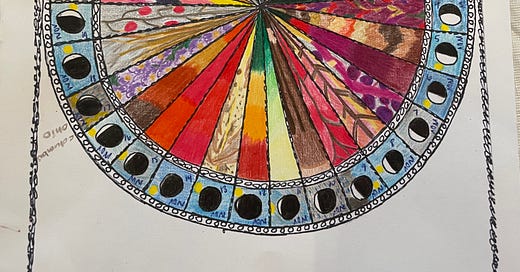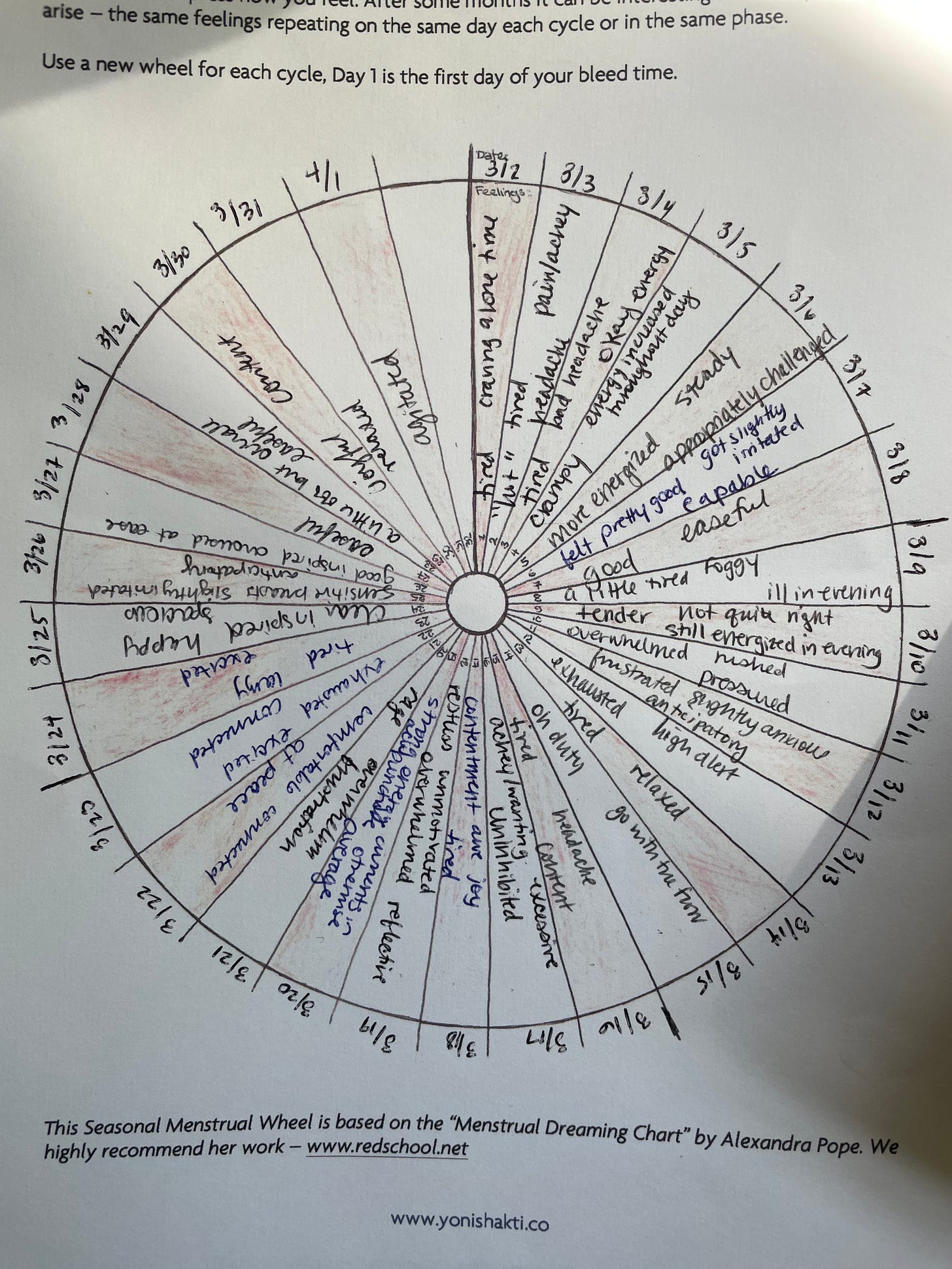How noticing nature became my daily yoga practice
Tuning in to cyclical wisdom with phenology wheels and cycle tracking
Yoga is a practice of noticing and observing. You notice where you place your body in a pose. You notice where you place your thoughts in meditation. You notice how you breathe in pranayama. You notice how you feel and act when living in accordance with the Yamas and Niyamas. Yoga is an endless practice of noticing and feeling all that life has to offer—the practice is a gift offering immense power through refined, and aligned, perception.
Most of us stop noticing somewhere along our life journey. Sometimes it’s because it hurts too much. Sometimes it’s because we get confused and give up. Sometimes it’s because we don’t have a safe space or a trusted friend or teacher to reflect back to us and affirm our experiences. These days it’s often because we’re distracted by little screens that sit in the palms of our hands, drawing us into a tunnel-vision of existence that isn’t even real, oblivious to everything around, outside, and inside of us that is. There are infinite reasons why you might stop noticing in your life. In a quest to fit in and adhere to society’s expectations, I contorted myself to fit into a box that never felt right. I became whatever others wanted me to become because I didn’t trust myself to know what I really wanted.
I’ve had enough experiences now to convince me I do know what is right and best for me. Whereas before I would say I didn’t have any connection to intuition, I now know my intuition is alive and well, I’ve just dismissed it for years. My body tells me what is happening, and it is my job to listen closely and respond appropriately. When I thought I was having a heart attack at age 20 and the doctors eventually told me it was costochondritis—a condition, apparently, according to one ER doctor, “common in young, skinny women who work out a lot”—my body was telling me to slow down. I didn’t listen. My panic attacks continued for years. Twelve years later, when I told the maternity ward receptionist that I was in labor and the baby was coming, I was listening. Unfortunately, the receptionist did not. She told me to sit down and wait my turn. I delivered my daughter in the triage room 40 minutes later. When I experienced an ovarian cyst rupture—the most pain I’ve ever felt in my life, and I’ve delivered both my children naturally with no medication—I knew something was not right. Though my pain wasn’t dismissed by my doctors, the unfortunate solution was ride it out and rest. My body was once again telling me to pay attention and there wasn’t much the Western medical system could do to help me.
How many times have you been told by a medical professional that there was nothing they could do for you (other than to prescribe you narcotics)? The ovarian cyst rupture was the last straw. It was time for me to deepen my relationship with my body, my intuition, and the natural world.
Observing Mother Nature with a phenology wheel
It all started with the phenology wheel. It’s easier to notice things outside yourself. At the end of October I started a daily practice of noticing and capturing the bold colors of the changing leaves—oranges, reds, deep purples. As late fall shifted into winter my eyes wandered to the skies—the ground offered nothing of interest in hibernation. I was drawn to water and air elements—blues, grays, blacks. In January, the buds started appearing on our April Snow Camellia. It’s amazing how long it can take a flower to bloom—so much energy to get to the blossom. February brought more color and the earliest signs of spring, a transitory juxtaposition of fallowness alongside winter blooms—glossy, red berries upon beds of deep green leaves. March introduced more flowers budding and blooming, caterpillars lurking, bald eagles soaring. The greens became a little lighter, a little brighter. The camellia graced us with its bountiful, snow-white blooms. A quick trip to Florida revealed the wonders of a tropical spring, with vibrant hibiscus and the colors of the sea briefly interrupting the temperate deciduous forest ecosystem at home. April brought bluebird firmaments, dark gray, cloudy skies and spits of rain sprinkled in here and there, and new flowers blooming every day—pastel pinks and purples, bright reds and greens.
I’m now on my seventh month of observing the daily transformation of the natural world outside my windows. My favorite observations have been the intricate details and natural designs in leaves, tree bark, and on animals. Natural patterns are fascinating and awe-inspiring to behold. I was surprised how early the buds showed up and how long it took for those buds to bloom. It was a great reminder that everything worth something in life takes time—even the fallow winter plays a part in blooming.
There was also tragedy. We had the pleasure of watching a pair of chickadees build a nest in one of my son’s football helmets in our carport. One day strong winds blew the helmet off its shelf and the nest fell to the concrete. I immediately feared for the eggs. I gently picked up the nest to make sure the eggs were okay only to discover that there were no eggs. Disaster averted! Later on in the day I discovered day-old baby birds strewn across the carport concrete, so small as to be almost unrecognizable, and smushed. Four baby birds perished that day and my heart was so heavy. Nature’s elements sustain life, but also bring death and this is part of the cycle too.
Cycle tracking with the wheel
I started recording my observations of nature to feel more connected to the natural world. This exploration of the seasons expanded to include tracking my menstrual cycle using a similar wheel. By observing my emotions/moods/energy throughout my own cycle I’ve been able to deduce how each season of my monthly cycle unfolds. Winter corresponds with menstruation; during these days I’m often exhausted and irritable. As winter transitions into spring I gain more energy; however, spring is a tumultuous season for me in my cycle and I often feel quite emotional. Spring corresponds with the follicular phase in the menstrual cycle when follicles prepare an egg for ovulation. Summer, corresponding with ovulation, brings surges of intense energy that can sometimes feel overwhelming to me. Fall corresponds to the luteal phase when the uterus prepares for a potential pregnancy. This season in my menstrual cycle is where I find the most steady, creative, and inspiring energy. A word that I wrote down continuously during this time in my chart: easeful.
By continuing to attune to my own personal seasons and the natural cycles of the world around me, I feel more connected to myself and to my relationship with the universe. I feel empowered knowing that nothing is permanent, that there is a season for everything, and that it’s okay to rest when I’m feeling depleted or to push myself a little when I’m feeling more energetic. Though I still get irritated/anxious/angry, I’m able to ride these emotions and not get so attached. I’m learning to feel and let go. By observing seasons and cycles I’m learning to trust myself and the laws of Mother Nature.
Women cycle through seasons their entire lives, with the menstrual cycle being the major cyclic force guiding energy (and all of human creation). Befriending this power—cycling is truly an incredible power of creation—is freeing. When your own internal rhythmic cycle stops—or before it has even begun—Mother Nature provides a reliable external rhythm to follow. She guides you, provides for you, cares for you, nurtures you. Especially in perimenopause when your personal inner rhythm starts to transition, it can be comforting to rely on the steady rhythm of nature in the absence of your own. You never stop cycling, you just become more connected to universal cycles.
Noticing has become an integral piece of my personal, daily yoga practice. It’s the noticing that keeps me present and grounded even when I’m anxious, annoyed, enraged, or depleted. It is simple, takes almost no time, requires very little in the way of “props,” can be transported with me anywhere, and is inconvenient only in the sense that I have to go outside, or at the very least look outside, every day. There is no better foundational practice for women’s wellbeing than this one. I encourage you to try it!
Cycle tracking resources
Resources for tracking nature
I was inspired to start a phenology wheel from a fabulous post by Megan Devine that appeared in the Roots issue of Taproot Magazine (January 2021; Issue 43). (I highly encourage you to purchase the single issue as this is such a fun, beautiful, ad-free, independent magazine). Subscribers can access downloadable phenology wheel templates. I’ve also found templates from searching on Pinterest. Or you can make your own if you have a compass and a ruler.
Resources for tracking moon cycles
I use the Moon Phases and Lunar Calendar App for tracking the moon cycles. There are lots of different apps and I’m sure they’re all fine. You don’t need anything special.
Resources for charting your menstrual cycle
For charting your menstrual cycle, I use a template provided by the Yoni Shakti: Well Woman Yoga Therapy Online Immersion program with Uma Dinsmore Tuli and Sivani Mata. The chart they use has been adapted from the Menstrual Dreaming Chart by Alexandra Pope of the Red School. You can get a free copy of that by signing up for the Red School email list. You can also do some Googling or create your own.
There are also many apps available for tracking menstrual cycles and while you could use any of these apps to create notes about mood/energy, I find I prefer the paper charts. I use/have used the Period Tracker app and Natural Cycles for tracking my cycle and fertility. Note that apps can share your data and this is becoming increasingly problematic for women in a post-Roe world. Perhaps old-school is the way to go here for privacy and safety.
Stay tuned for more yoga practices specifically for menstrual health.
Let’s chat in the comments
Have you ever done a phenology wheel? Are you interested in trying it?
What do you notice about the world around you (inside or outside) today?
Do you track your cycle? What patterns have emerged for you?







Beautiful! I'd never heard of a phenology wheel before, but I like the idea. Maybe I'll try it. Lately I've noticed a bit of unpredictability in the world around me (climate-wise) and also within me (am I approaching perimenopause, or maybe breastfeeding a toddler throws my cycles for a loop...). I track my cycles with the Clue app but have been considering moving to pen and paper format. I recently started taking the Love Your Cycle course through the Red School and it's great!
Looks like a very powerful practice. So many aspects to it. Such a tangible and beautiful way to note and experience each moment as process rather than as some sort of a set 'thing'. Thank you for this.